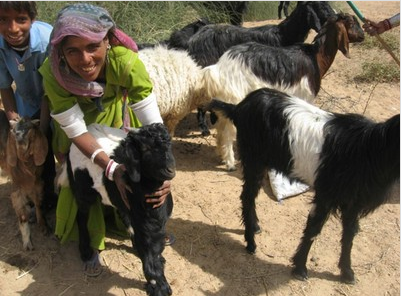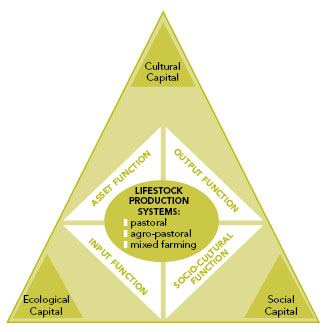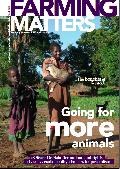Animals are a part of farming systems everywhere. In this issue, Farming Matters focuses on how small-scale farmers manage their animals, how they link animal husbandry with other activities, and what their livestock means to them. An integrated perspective on the role of farm animals is crucial in overcoming simplistic assumptions on the opportunities and threats that livestock presents to family farmers.
Livestock plays an important role in the livelihoods of many farmers and herders in the South, as it contributes to the basics of food, income, and security, as well as other social and cultural functions.
Actually, the world’s poorest people – nearly one billion – depend on pigs, yaks, cattle, sheep, lamas, goats, chickens, camels, buffalos and other domestic animals.

In other parts of the world, we see an over-consumption of red meat and other animal-based food, which damages the health of many people: it is a shocking dichotomy.
Animals and greenhouse gases
According to the FAO study, Livestock’s long shadow: Environmental issues and options, published in 2006, livestock contributes to 18 percent of the total global greenhouse gas emissions generated by human activity. Most of these emissions come from countries using industrial farming practices, in the form of methane produced by the belching and flatulence of animals, carbon dioxide by felling and burning trees for ranching, and nitrous oxide by spreading manure and slurry over the land. It is therefore a problem predominantly caused by Western consumption patterns, as has been discussed and studied by many researchers and authors (for example, Jonathan Safran Foer in Eating animals). For some people, it is a reason to promote a vegetarian lifestyle, as a protest against animal exploitation.
There are, however, great differences in livestock production systems in various regions of the world. These systems emit very different amounts and types of greenhouse gases, and serve different purposes. Considering that all of Africa’s ruminants together account for 3 percent of the global methane emissions from livestock, their contribution is minor. But as Carlos Seré, director of the International Livestock Research Institute (ILRI), rightly points out, ruminants maintained on poor quality feeds (see Meet Miss Buffalo) make an inefficient conversion of feed to milk and meat, and are more environmentally damaging. Skinny ruminants on poor diets, while not competing with people for grain, produce much more methane per unit of livestock product than well-fed cattle, sheep and goats.
Yet many African livestock systems seem to be the best way to deal with climate change because these systems can be carbon-negative. According to Mario Herrera and Shirley Tarawali from ILRI, a typical 250 kilogram African cow produces approximately 800 kilogram CO2 equivalents per year, whilst carbon sequestration rates (the amount of carbon taken up in the soil) can be about 1400 kilograms of carbon per hectare per year under modest stocking rates, making a positive balance. The same goes for stall-feeding dairy systems, which emit less CO2 due to higher quality diets and better recycling of products within the system.
Livestock revolution revisited
The notion of a “Livestock Revolution” was introduced in an influential IFPRI publication in 1999. It initially simply stood for the unprecedented growth in demand for food of animal origin in developing countries, because of population growth, urbanisation and increasing income (and subsequent changes in diets and life style).
Meet Miss Buffalo
The models were hefty, horned, heavily made-up and hooved: everything you would expect from contestants at a beauty contest for water buffalo in India. About 125 buffalos, decorated with colourful cloths and ornaments, took part in the event and plodded down a makeshift stage as the crowds cheered. “The objective of the show was to teach villagers to take care of the poor animals,” said Prabhat Ranjan, organiser of the event: “Buffalos are underfed and as a result, their milk production is decreasing.” In rural Bihar, most villagers depend on selling buffalo milk to earn their living and they could improve the milk production by giving their animals proper feeding and disease prevention. Source: The Economic Times, 28 Oct. 2009.
The idea that the Livestock Revolution would be driven by demand, contrary to the Green Revolution which was supply-driven, strongly influenced the thinking in the sector.
The growth in demand could imply enormous opportunities for the poor, who could catch a substantial share of the growing livestock market. But just 10 years later, Ugo Pica-Ciamarra and Joachim Otte show in The livestock revolution: Rhetoric and reality, that this growth has been especially huge in China, India and Brazil in the poultry, pork and dairy sectors. In sub-Saharan Africa and developed regions, the growth has been decreasing or stagnant. The geographical impact is patchy even within the nations and the impact is largest on poor urban consumers. The paper also observes that an increasing polarisation has occurred in the livestock sector.
Local developments
The World Bank has acknowledged the notion of a Livestock Revolution from the beginning, seeing opportunities for poor small-scale farmers in developing countries. Jimmy Smith, from the Agriculture and Rural Development department of the World Bank, admits that growth in the demand for animal products has not been uniform: “Income growth has happened fastest in China, and therefore, growth in demand for livestock products happened fastest there. South East Asia also recorded impressive growth in demand for milk, poultry meat and eggs.” For Smith it does not mean that the Livestock Revolution did not happen: “Despite regional differences, changes have been so large that it has influenced global trade, and raised issues about livestock and climate even in the developing world. As small holders are often not connected to markets, they have not been able to benefit as we would have expected.”

For Smith, policy makers need to be more active to allow them to benefit: “It’s mostly very large scale producers that have benefited from the Livestock Revolution. Public spending has been very low. Veterinary services have deteriorated. And there have been little investments in linking small holders to markets, perhaps with the exception of India, and on making livestock systems more environmentally sustainable.” There are more examples indicating that the livestock sector is influenced by other factors, such as food price policies, availability of animal feed and investment facilities for commercial farming.
The idea of a livestock sector that grows as a result of increased demand for meat is therefore misleading. It prevents governments from intervening and identifying the real potentials that could stimulate a growth in the livestock sector that would be beneficial to poverty reduction and rural development at large. The debate on page 19 focuses on this aspect.
Mixed farming
In Eastern Africa, one third of the rural population lives in areas where livestock predominate over crops as a source of income. Nearly 40 percent of all livestock are kept in mixed farming areas, where they contribute to rural livelihoods in diverse ways. Various classifications are used to define livestock production systems.
From a family farming perspective, livelihood criteria known as “the relative dependency on livestock at the household level”, including the customary use of the terms “pastoral”, “agro-pastoral”, and “mixed farming”, place the livestock into perspective with all the activities and resources through which households fulfil their needs.
Clean pigs
The rather panicky reaction to the swine flu in Egypt last year shows how important it is to keep looking at the different functions and dimensions of livestock. The Egyptian government announced a ban on pig rearing in Egypt, which has led to streets being littered with rotting food piles. What started out as an impulsive response to the swine flu threat, turned into a social, environmental and political problem for the most populous nation in the Arab world. For more than half a century, the waste collectors in Cairo were the Zabaleen, a community of Egyptian Christians who live on the cliffs on the eastern edge of the city. They collected the trash, sold whatever recyclables they found and fed the organic waste to their pigs, which they kept for consumption. Cairo’s garbage collection therefore belonged to the informal sector. The government has now hired multinational companies to collect the trash, which have decided to place bins around the city. They failed to understand the ethos of the community, as people do not take their garbage out. Rather, they are accustomed to having someone collect it at the door. The result is that the streets are now littered and a large community is without work and income. Pigs are not just pigs, but form an important aspect in the livelihood strategies of distinct communities, and even contribute to the well-being of more affluent groups in society.
An agro-pastoral system would be one in which livestock account for between 50 and 80 percent of the total income, whereas a pastoral system would have livestock accounting for over 80 percent. We must be wary of making generalised statements about the links between livestock, consumption of meat, greenhouse gas emissions, climate change, food safety, poverty and animal welfare issues.
The context, functions of livestock and trade-offs of animal husbandry are very different all over the world. The crux of the matter is to reach a situation in which family farming and herding in the South meet future demands for animal products without environmental damage.
Strengthening and/or developing ecological, cultural and socially-sound livestock systems is possible, but it starts with understanding the different functions of livestock in rural livelihoods.
More than meat and milk
Farmers keep animals for direct consumption of food and non-food products such as milk, meat, wool, hair and eggs, but also manure for fuel, and urine for medicine (output function). Some of these products provide input for other activities: manure, urine and grazing fallow land are beneficial for crop production; stubble fields help pastoralists feed their animals; animals give drought power for transport, and their hair, hoofs and manure help to disperse seeds and improve seed germination; their grazing prevents bushfires and controls shrub growth, and stimulates grass tillering and breaking-up hard soil crusts (input function). But animals also permit farmers to raise money in times of need (asset function).
This often represents the priority function of livestock among poor farmers, and is the reason that animals are not necessarily sold when the market price is attractive but when there is a need for cash. Livestock are also part of the household. They are indicators of social status: festivals and fairs are based on livestock (bullock cart racing, cock fighting, cow beauty contests) and many songs have been written about livestock (socio-cultural function).
Van der Ploeg (2009) brings in the dimension of capital when analysing farming systems in his book New peasantries. There is the conversion of living nature (ecological capital) into food, drinks and a broad range of raw products. But controlling the complex organisation and development of farming, needs communities to network, co-operate, self-regulate, solve conflicts, and engage in learning processes (social capital). Finally, farming and herding stand for a certain culture and way of life (cultural capital), which are even more clearly articulated in these modern times, with anonymous global markets. Farming culture stands for origin, quality, authenticity and freshness of products, and of associated ways of producing, processing and marketing (fairness and sustainability). The analyses of Rangnekhar (2006) and Van der Ploeg (2009) can be combined in the diagram at the top of this page. The World Bank has already tried to adopt a more inclusive approach to livestock. Smith points out that livestock is mostly used for input into crops: “Some reports say that up to 50 percent of nitrogen use for crops comes from manure, which means that livestock is incredibly important. Livestock has many uses and functions, which have not received enough attention. Public investments are needed, in order to sustainably develop the livestock sector and escape poverty.
Climate smart development
Neglected zoonoses
Zoonotic diseases are transmitted from vertebrate animals to people and thus can compromise people’s health and endanger their livelihoods. Many of these diseases are prevalent in the developing world and affect the poorest segments of the human population. Neglected zoonoses, such as anthrax, rabies, brucellosis, bovine tuberculosis, zoonotic trypanosomiasis, echinococcosis, cysticercosis and leishmaniasis, are major causes of ill health in people in Africa, Asia and Latin America. The burden of these diseases on affected communities is compounded by the adverse effects on the productivity of livestock and hence on the livelihoods of the poor. Only recently have Western companies and research institutes taken more interest in these diseases. Previously, money and time has mostly been devoted to animal diseases affecting industrial livestock production, such as swine flu and Q fever. It is important to understand that one can jointly approach human and animal health.
For more information visit: www.galvmed.org.
A recent study by Delgado (2008) on the scaling-up of the production of some specific livestock products among small-scale producers in Brazil, India, the Philippines and Thailand, has focused on the impact of increasing the average farm size and annual livestock sales. There are some interesting conclusions regarding family farming that can be noted. Independent small farms in India and the Philippines typically have higher profits per unit than do independent large farms. Small farms with pigs and poultry also have a lower negative impact on the environment than large farms. Hence, environmental concerns are compatible with promoting small-scale livestock production. Climate-smart farming is the future, as Camilla Toulmin, director of the International Institute for Environment and Development (IIED) stated at the ILEIA conference on the Future of Family Farming in The Hague in December 2009.
In this issue of Farming Matters, you will find a number of good practices and research findings that are in line with the thoughts expressed in this theme overview. They show alternative pathways to the rather linear value-chain approach, which tends to focus on the output function while giving little attention to other functions, nor having much consideration for the social, ecological and cultural capital that livestock offer. The competitiveness of smallholders is largely determined by low-cost family labour, but in order to improve the situation for farmers, some farm-specific barriers, such as credit and market information, should be addressed. Farmers also need quality animal and human health services (see box Zoonoses), as well as extension services and other pro-poor livestock interventions. Only then will climate-smart rural development pay off for smallscale farmers.
Text: Lucy Maarse
References
- Delgado, C., 2008. Determinants and implications of the growing scale of livestock farms in four fast-growing developing countries. Research report 157, IFPRI, Washington, DC, U.S.A.
- Delgado C., M. Rosegrant, H. Steinfeld, S. Ehui and C. Courboi, 1999. Livestock to 2020, the next food revolution: Food, agriculture and the environment. Discussion Paper 28, IFPRI, Washington, DC, U.S.A.
- Van der Ploeg, J.D., 2009. The new peasantries: Struggles for autonomy and sustainability in an era of empire and globalization. Earthscan, London, U.K.
- Pica-Ciamarra, U. and J. Otte, 2009. The livestock revolution: Rhetoric and reality. Research report 09-05, Pro-Poor Livestock Policy Initiative, FAO, Rome, Italy.
- Rangnekar D., 2006. Livestock in the livelihoods of the underprivileged communities in India: A review. ILRI, Nairobi, Kenya.
- Steinfeld, H., P. Gerber, T. Wassenaar, V. Castel, M. Rosales and C. de Haan, 2006. Livestock’s long shadow: Environmental issues and options. Animal Production and Health Division, FAO, Rome, Italy.
- Sere, C., 2009. It’s time for climate negotiators to put meat on the bones of the next climate agreement. Blog posted at ILRI’s website, available at www.ilri.org/ilrinews/index.php/archives/1006/comment-page-1#comment-50.
Lucy Maarse (lucy.maarse@gmail.com) is an independent advisor (Livestock & Livelihood) specialised in tropical animal production and extension, currently working from the Netherlands.

